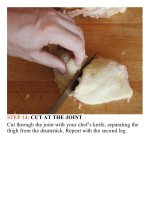The food lab better home cooking through science ( PDFDrive ) 468
Bạn đang xem bản rút gọn của tài liệu. Xem và tải ngay bản đầy đủ của tài liệu tại đây (133.66 KB, 2 trang )
BeerCOOLERS,Plastic
BAGS,
ANDTHESCIENCEOFSOUS-VIDE
There’s been a small revolution going on in restaurant
kitchenssincetheearly2000s.It’schangedeverythingfrom
the way line cooks cook and chefs conceive dishes and
menustothewayfastfoodchainsmaintainconsistencyand
organize their workflow. I’m talking sous-vide, from the
French for “under vacuum,” the cooking method wherein
food is placed in a vacuum-sealed pouch and cooked in a
temperature-controlled water bath. The technique was first
introduced to the public in the 1970s at MichelTroisgros’
eponymousrestaurantinRoanne,France,butitwasn’tuntil
early in this century, when chefs gained access to very
precise, laboratory-grade equipment that it became both
practicalandpossibletoimplementonalargescale.
You may be thinking: “OK, interesting, but I’m a home
cook, and I couldn’t tell a water circulator from a rotary
evaporator—what’s this got to do with me?” You’ll just
havetotrustthatI’llgetthereinamoment.
According to famed British chef Heston Blumenthal of
The Fat Duck, outside London, “Sous-vide cooking is the
single greatest advancement in cooking technology in
decades,” and he’s not the only one who thinks so.
Everyone from Thomas Keller of New York’s Per Se and
California’s The French Laundry to your local Chipotle
MexicanGrillisservingfoodcookedsous-vide.
Here’s what’s great about it. Recall the problem of
temperature gradients developing in meat? To recap, food
cooksfromtheoutsidein,whichmeansthattheouterlayers
are going to be hotter than the very center. Thus, cooked
foods develop an internal bull’s-eye pattern: perfectly
cooked at the very center and increasingly overcooked as
youmoveouttotheedges.
So, for example, imagine you’re starting with a steak
that’s a consistent 40°F through and through. Place it in a
500°F pan, and the outer layers will almost immediately
reach around 212°F, the temperature at which the internal
moisture at the surface of the steak starts to evaporate.
Eventually all the moisture will dissipate and the
temperatureoftheouterlayersofthesteakwillcontinueto
increase. It’s quite easy for those outer layers to achieve
temperatures in excess of 200°F (that’s beyond the welldone160°Fstageforsteak)beforethecoretemperaturehas
even begun to shift. By the time the center reaches 130°F
(medium-rare),theouterlayersarehopelesslyovercooked.
Nowimaginecookingthesamesteakinaconstant130°F
environment. Sure, it’ll take much longer for the center to
get up to 130°F, but it’ll get there eventually and, in the
meantime,theouterlayershavenochanceofovercooking.
That’s precisely what sous-vide cooking is all about. If
youplacethemeatinanairtightvacuum-sealedpouchand
submerge it in a temperature-controlled water bath, the
water very efficiently transfers heat energy to the steak
while maintaining a very precise temperature.The result is
meatthat’scookedevenlyfromedgetoedge.









